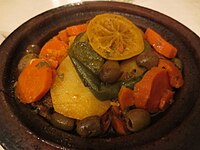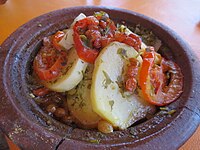Tajine
 A vegetable tajine dish as served in a London restaurant | |
| Alternative names | Tagine |
|---|---|
| Type | Stew or casserole |
| Place of origin | Morocco, Algeria, Tunisia , Egypt, Libya |
| Region or state | North Africa |
| |

Tajine statue in Safi, Morocco
A tajine or tagine (Moroccan Arabic طجين tažin, from Arabic: طاجن tājun; Tifinagh: ⵜⴰⵊⵉⵏ) is a Maghrebi dish which is named after the earthenware pot in which it is cooked. It is also called a Maraq/marqa.
Contents
1 Etymology
2 Origin and history
3 Pottery
4 Moroccan and Algerian tajine
5 Tunisian tajine
6 Other
7 See also
8 References
9 Further reading
10 External links
Etymology
From Moroccan Arabic طجين tažin, from Arabic طاجن tājun "shallow earthen pot",[1][2] from Ancient Greek: τάγηνον tagēnon "frying-pan, saucepan".[3][4][5]
Origin and history
The tagine dates back to Harun al-Rashid, a ruler of the Early Muslim conquests.[6][7][8][9] The earliest writings about the concept of cooking in a tajine appear in the famous One Thousand and One Nights, an Arabic-language story collection from the ninth century.[9] It is also mentioned during the Abbasid Caliphate (which stretched from the Middle East to North Africa and al-Andalus during the ninth century).[10] The dish would have been already famous amongst the nomadic Bedouin people of the Arabian Peninsula, who added dried fruits like dates, apricots and plums to give it its unique taste. Tagine is now often eaten with french fries, either on the top or on the side.
Today, the cooking-pot and its traditional broth is primarily prepared in the Middle East and North Africa. In North Africa it is called a Tajine, while in the Middle East it is called a maraq (broth) or a qidra (cooking pot). There are different ways to prepare the tajine. In the original qidra style saman (clarified butter) is used to lubricate the surface and a puree of chopped onion is added for flavour and aroma. For muqawlli-style cooking, the ingredients are placed in olive oil to enrich the flavours.
There are many descriptions of how to prepare a tajine from Arab scholars. A famous description is the one from ibn al-Adim (1192–1262):
.mw-parser-output .templatequote{overflow:hidden;margin:1em 0;padding:0 40px}.mw-parser-output .templatequote .templatequotecite{line-height:1.5em;text-align:left;padding-left:1.6em;margin-top:0}
Boil the meat and fry with fresh coriander, onions and hot spices and a little garlic. Then pick out the fennel hearts and cut in half. Put over the meat. Put back some of the broth on it along with sheep's tail. Boil until cooked and the broth has been absorbed. Remove [from the heat].
— Ibn al-Adim, Kitab Al Wuslah il Al-Habib fi wasf al tayyibat wa Al-Tib
Pottery
The traditional tajine pottery, sometimes painted or glazed, consists of two parts: a circular base unit that is flat with low sides and a large cone- or dome-shaped cover that sits on the base during cooking. The cover is designed to return all condensation to the bottom. That process can be improved by adding cold water into the specially designed well at the top of the lid.
Tajine is traditionally cooked over hot charcoal leaving an adequate space between the coals and the tajine pot to avoid having the temperature rise too quickly. Large bricks of charcoal are used, specifically for their ability to stay hot for hours. Other methods are to use a tajine in a slow oven or on a gas or electric stove top, on the lowest heat necessary to keep the stew simmering gently. A diffuser, a circular utensil placed between the tajine and the flame, is used to evenly distribute the stove's heat. European manufacturers have created tajines with heavy cast-iron bottoms that can be heated on a cooking stove to a high temperature, which permits the browning of meat and vegetables before cooking.
Tajine cooking may be replicated by using a slow cooker or similar item, but the result will be slightly different[citation needed]. Many ceramic tajines are decorative items as well as functional cooking vessels. Some tajines, however, are intended only to be used as decorative serving dishes.

Tajine potter
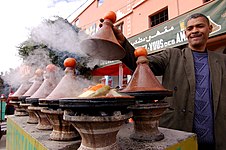
Tajine cooking
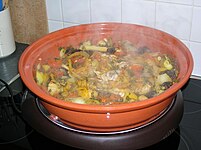
Electrical tajine
Tajine used outdoors
Moroccan and Algerian tajine
Moroccan tajine dishes are slow-cooked savory stews, typically made with sliced meat, poultry or fish together with vegetables or fruit.[11] Spices, nuts, and dried fruits are also used. Common spices include ginger, cumin, turmeric, cinnamon, and saffron. Paprika and chili are used in vegetable tajines. The sweet and sour combination is common in tajine dishes like lamb with dates and spices. Tajines are generally served with bread. Because the domed or cone-shaped lid of the tajine pot traps steam and returns the condensed liquid to the pot, a minimal amount of water is needed to cook meats and vegetables. This method of cooking is practical in areas where water supplies are limited or where public water is not yet available.
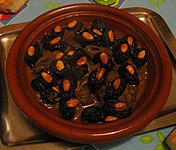
Lamb, prunes and almonds
Lamb with plum and eggs
Tajine with olives and vegetables
Tajine
Tajine with almonds
Tajine with carrots
Tajine with lamb and mango
Tajine with chicken
Tunisian tajine
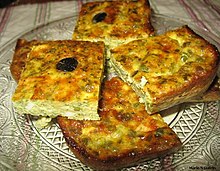
Tunisian tajine
What Tunisians refer to as a "tajine" is very different from the Moroccan dish.[12]Tunisian tajine is more like an Italian frittata or an eggah. First, a simple ragout is prepared, of meat cut into very small pieces, cooked with onions and spices, such as a blend of dried rosebuds and ground cinnamon known as baharat or a robust combination of ground coriander and caraway seeds; this is called tabil.[13] Then something starchy is added to thicken the juices. Common thickeners include cannellini beans, chickpeas, breadcrumbs or cubed potatoes. When the meat is tender, it is combined with the ingredients which have been chosen to be the dominant flavouring. Examples include fresh parsley, dried mint, saffron, sun-dried tomatoes, cooked vegetables and stewed calves' brains. Next, the stew is enriched with cheese and eggs. Finally, this egg and stew is baked in a deep pie dish, either on the stove or in the oven until top and bottom are crisply cooked and the eggs are just set. When the tajine is ready, it is turned out onto a plate and sliced into squares, accompanied by wedges of lemon. Tunisian tajines can also be made with seafood or as a completely vegetarian dish.
In rural parts of Tunisia, home cooks place a shallow earthenware dish over olive-wood coals, fill it, cover it with a flat earthenware pan, and then pile hot coals on top. The resulting tajine is crusty on top and bottom, moist within and is infused with a subtle smoky fragrance.

Outdoor cooking using a tajine
Other
A similar dish known as tavvas is found in Cypriot cuisine.
See also
- List of African dishes
- List of egg dishes
- Berber cuisine
- List of stews
- Rfissa
- List of cooking vessels
 Food portal
Food portal
References
^ "Oxford"..mw-parser-output cite.citation{font-style:inherit}.mw-parser-output .citation q{quotes:"""""""'""'"}.mw-parser-output .citation .cs1-lock-free a{background:url("//upload.wikimedia.org/wikipedia/commons/thumb/6/65/Lock-green.svg/9px-Lock-green.svg.png")no-repeat;background-position:right .1em center}.mw-parser-output .citation .cs1-lock-limited a,.mw-parser-output .citation .cs1-lock-registration a{background:url("//upload.wikimedia.org/wikipedia/commons/thumb/d/d6/Lock-gray-alt-2.svg/9px-Lock-gray-alt-2.svg.png")no-repeat;background-position:right .1em center}.mw-parser-output .citation .cs1-lock-subscription a{background:url("//upload.wikimedia.org/wikipedia/commons/thumb/a/aa/Lock-red-alt-2.svg/9px-Lock-red-alt-2.svg.png")no-repeat;background-position:right .1em center}.mw-parser-output .cs1-subscription,.mw-parser-output .cs1-registration{color:#555}.mw-parser-output .cs1-subscription span,.mw-parser-output .cs1-registration span{border-bottom:1px dotted;cursor:help}.mw-parser-output .cs1-ws-icon a{background:url("//upload.wikimedia.org/wikipedia/commons/thumb/4/4c/Wikisource-logo.svg/12px-Wikisource-logo.svg.png")no-repeat;background-position:right .1em center}.mw-parser-output code.cs1-code{color:inherit;background:inherit;border:inherit;padding:inherit}.mw-parser-output .cs1-hidden-error{display:none;font-size:100%}.mw-parser-output .cs1-visible-error{font-size:100%}.mw-parser-output .cs1-maint{display:none;color:#33aa33;margin-left:0.3em}.mw-parser-output .cs1-subscription,.mw-parser-output .cs1-registration,.mw-parser-output .cs1-format{font-size:95%}.mw-parser-output .cs1-kern-left,.mw-parser-output .cs1-kern-wl-left{padding-left:0.2em}.mw-parser-output .cs1-kern-right,.mw-parser-output .cs1-kern-wl-right{padding-right:0.2em}
^ "tagine". Collinsdictionnary.
^ Albala, Ken (2011). Food Cultures of the World Encyclopedia, Volume 1. Greenwood. p. 234. ISBN 0313376263.The Arabic word tajin is derived from the Greek teganon, meaning “frying pan".
^ τάγηνον, Henry George Liddell, Robert Scott, A Greek-English Lexicon, on Perseus
^ "الطاجين المغربي يقاوم التشويه". BBC Arabic. 31 May 2008. Retrieved 12 December 2012.
^ "The Origin of Tagine". Kous Kous Moroccan Bistro. Retrieved 2017-10-14.
^ Roden, Claudia (2008-12-24). The New Book of Middle Eastern Food. Knopf Doubleday Publishing Group. ISBN 9780307558565.
^ 0. "Tagine in heartwarming spoonfuls". english.alarabiya.net. Retrieved 2017-10-14.
^ ab Snodgrass, Mary Ellen (2004-12-29). Encyclopedia of Kitchen History. Routledge. ISBN 1135455716.
^ "Origins of Food We Love: Moroccan Tagine". G Adventures Blog. Retrieved 2017-10-14.
^ "The Art of Moroccan Cuisine". fescooking.com.
^ Paula Wolfert. "Recipe for Tunisian Tajine". Retrieved 2014-07-21.
^ Nancy Harmon Jenkins. "Divine Secrets of the Mahjoub Sisterhood". Retrieved 2008-04-27.
Further reading
Connelly, Michael Alan (December 18, 2014). "20 Must-Try Street Foods Around the World". Fodor's. Retrieved July 24, 2016.
External links
| Wikimedia Commons has media related to Tajines. |
| Look up tajine in Wiktionary, the free dictionary. |
- Calories in Moroccan Chicken Tagine






